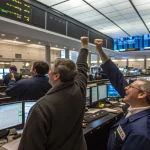Australian shares plummeted in the biggest one-day fall since the COVID-19 pandemic, with the ASX 200 dropping 4.2 percent. Nearly $110 billion in market value was wiped off in a single session, as former US President Donald Trump’s tariffs sparked fears of a global trade war and recession. All sectors were impacted, with energy and mining stocks particularly hard-hit due to declining commodity prices.
Betashares chief economist David Bassanese noted that few winners emerge from a trade war, with traditional defensive stocks outperforming cyclical ones. Treasurer Jim Chalmers acknowledged the substantial upheaval in global and local stock markets, as the Australian dollar also came under pressure, closing at around 60.2 US cents. Expectations of further interest rate cuts by the Reserve Bank of Australia (RBA) contributed to the currency’s decline.
Regional markets experienced severe losses, with Hong Kong’s Hang Seng index crashing by 11.5 percent, driven by a significant fall in its tech sector. Japan’s Nikkei and the Shanghai Composite also saw steep declines. European markets followed the downward trend, with Germany’s DAX and London’s FTSE falling sharply.
Futures trading on Wall Street’s S&P 500 and Nasdaq pointed to further losses. Despite the widespread losses, some stocks managed gains, such as Challenger, which rose by 6.9 percent after a Japanese life insurance company acquired a 15 percent stake.
Australian shares plummet amid global turmoil
Investment strategists suggest that the market is already pricing in a recession, and a “circuit breaker” is needed to stabilize the situation. Analysts will be closely watching the RBA’s upcoming decisions in May, where further rate cuts are anticipated. The tariff-induced market ructions are hitting Australians’ superannuation savings, with experts warning against ‘knee-jerk reactions’ and suggesting it is not time to panic.
The current situation echoes the global financial crisis (GFC) in many ways, with some key differences. Donald Trump’s tariffs are seen as a deliberate plan to destroy the liberal global trading and financial system established by the US. Satyajit Das, an analyst who warned about the risks of the GFC before they eventuated, argues that the Trump administration is risking permanent damage to US capital markets.
He suggests that restructuring US debt, as proposed by some in the administration, would constitute a technical default and accelerate America’s fall from greatness. The Australian dollar fell to its lowest level against the US dollar since the pandemic, as global markets sold off. The local currency, closely linked to commodity prices, would suffer if global economic activity slowed, especially in China.
AMP economist My Bui noted the reliance of Australia’s economy on iron ore exports, stating that concerns about a global slowdown due to tariffs and a potential trade war lead to less demand for Australian commodities. As the global market reaction continues to evolve, investors are closely monitoring developments in US-China trade relations and the broader implications for economic activity.







